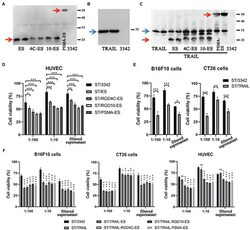Antibody data
- Antibody Data
- Antigen structure
- References [2]
- Comments [0]
- Validations
- Other assay [1]
Submit
Validation data
Reference
Comment
Report error
- Product number
- MA1-40230 - Provider product page

- Provider
- Invitrogen Antibodies
- Product name
- Endostatin Monoclonal Antibody (1837-46)
- Antibody type
- Monoclonal
- Antigen
- Recombinant full-length protein
- Description
- MA1-40230 detects Endostatin from human samples. MA1-40230 has been successfully used in ELISA, flow cytometry, immunohistochemistry (frozen), immunohistochemistry (paraffin), and Western blot applications. For staining of paraffin sections antigen retrieval (microwave irradiation in citrate buffer) is advised. The MA1-40230 immunogen is human endostatin.
- Reactivity
- Human
- Host
- Mouse
- Isotype
- IgG
- Antibody clone number
- 1837-46
- Vial size
- 100 µg
- Concentration
- 0.1 mg/mL
- Storage
- 4°C
Submitted references Optimized Attenuated Salmonella Typhimurium Suppressed Tumor Growth and Improved Survival in Mice.
Immunohistochemical analysis of non-small cell lung cancer: correlation with clinical parameters and prognosis.
Liang K, Zhang R, Luo H, Zhang J, Tian Z, Zhang X, Zhang Y, Ali MK, Kong Q
Frontiers in microbiology 2021;12:774490
Frontiers in microbiology 2021;12:774490
Immunohistochemical analysis of non-small cell lung cancer: correlation with clinical parameters and prognosis.
Yoo J, Jung JH, Lee MA, Seo KJ, Shim BY, Kim SH, Cho DG, Ahn MI, Kim CH, Cho KD, Kang SJ, Kim HK
Journal of Korean medical science 2007 Apr;22(2):318-25
Journal of Korean medical science 2007 Apr;22(2):318-25
No comments: Submit comment
Supportive validation
- Submitted by
- Invitrogen Antibodies (provider)
- Main image

- Experimental details
- Figure 4 The expression of endostatin and/or TRAIL by optimized Salmonella and their in vitro cell-killing activities. (A,B) The expression of endostatin (ES, RGD4C-ES, RGD10-ES, and PSMA-ES; 25.2, 28.1, 28.4, and 52.6 kDa) and TRAIL (34.3 kDa) by engineered Salmonella strain D2-asd was detected by western blotting, respectively. The samples tested were prepared from bacterial lysates. (C) Recombinant Salmonella co-expressing endostatin and TRAIL were also constructed and verified in the same way. (D-F) The toxicity of recombinant Salmonella bacteria expressing endostatin and/or TRAIL to HUVECs and cancer cells at the MOI of 1:100 or 1:10 were tested by the CCK-8 assay. Besides, the filtered medium supernatant of bacterial culture containing secreted anti-tumor molecules was also added to cells for testing. The cell viability shown (%) was relative to that of untreated cells, followed by comparison among groups by two-way ANOVA analysis. The cell viability shown (%) was relative to that of untreated cells. Difference significance between ST/3342 and other groups was analyzed through two-way ANOVA analysis followed by Tukey's multiple comparisons test (* p < 0.05; ** p < 0.01; and *** p < 0.001).
 Explore
Explore Validate
Validate Learn
Learn Western blot
Western blot Other assay
Other assay